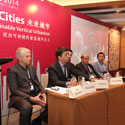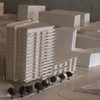Filter by

WINDTECH Consultants is a company of consulting engineers specializing in the analysis of wind effects on buildings, structures and the environment. Since 1991, the company has been providing wind engineering and related high technology services for over 2,000 major building projects, assisting planners and building design professionals.
The trend to building taller, larger and lighter structures has highlighted the need for specialist services in providing accurate analyses of the effect of winds. This generally results in significant savings in the cost of the facade and the structure in comparison with the use of estimates from wind loading standards.
Analysis techniques developed by WINDTECH Consultants over the past few years place the company at the forefront of its field in the analysis of the effect of wind on the most complex structures.
Environmental Engineering; Other; Wind Engineering
Membership Level
Gold
Member Since
2009
Member Offices
Sydney

CTBUH MEP Systems Committee, 2018 – Present

CTBUH Expert Peer Review Committee, 2018 – Present

16 September 2014
Innovative Designs for Natural Ventilation in High-Rise Buildings
Consideration of energy efficient design strategies has become one of the primary considerations by leading architectural firms during the conceptual design phases and is an...

16 September 2014
Innovative Designs for Natural Ventilation in High-Rise Buildings
Consideration of energy efficient design strategies has become one of the primary considerations by leading architectural firms during the conceptual design phases and is an...

19 September 2012
Tuned Liquid Dampers for the Economic Design of a Tall Building
Rasuna Tower is an office and hotel development in Jakarta, Indonesia with 63 above-ground stories and four basements and is 280 meters tall. The lateral...
Rank |
Name |
City |
Completion |
Height |
|---|---|---|---|---|
|
1 |
- |
445 m / 1,460 ft |
||
|
2 |
- |
400 m / 1,312 ft |
||
|
3 |
2012 |
355 m / 1,166 ft |
||
|
3 |
2013 |
355 m / 1,166 ft |
||
|
5 |
- |
351 m / 1,152 ft |
||
|
6 |
2010 |
326 m / 1,070 ft |
||
|
7 |
2005 |
323 m / 1,058 ft |
||
|
8 |
2021 |
308 m / 1,010 ft |
||
|
9 |
2014 |
308 m / 1,010 ft |
||
|
10 |
- |
305 m / 1,001 ft |
||
|
11 |
- |
305 m / 1,001 ft |
||
|
12 |
- |
300 m / 984 ft |
||
|
13 |
- |
298 m / 979 ft |
||
|
14 |
2016 |
286 m / 937 ft |
||
|
15 |
2021 |
277 m / 909 ft |
||
|
16 |
2022 |
263 m / 863 ft |
||
|
17 |
2017 |
262 m / 858 ft |
||
|
18 |
2021 |
260 m / 853 ft |
||
|
19 |
2016 |
260 m / 852 ft |
||
|
20 |
2013 |
251 m / 824 ft |
||
|
21 |
- |
251 m / 823 ft |
||
|
22 |
2014 |
250 m / 820 ft |
||
|
23 |
2019 |
249 m / 817 ft |
||
|
24 |
2010 |
245 m / 804 ft |
||
|
25 |
2019 |
244 m / 802 ft |
||
|
26 |
2012 |
243 m / 796 ft |
||
|
27 |
2012 |
239 m / 784 ft |
||
|
28 |
2020 |
237 m / 776 ft |
||
|
29 |
2020 |
232 m / 760 ft |
||
|
30 |
- |
230 m / 755 ft |
||
|
31 |
2010 |
227 m / 745 ft |
||
|
32 |
2013 |
227 m / 744 ft |
||
|
33 |
2017 |
226 m / 740 ft |
||
|
34 |
2017 |
220 m / 722 ft |
||
|
35 |
2011 |
214 m / 702 ft |
||
|
36 |
2017 |
214 m / 700 ft |
||
|
36 |
- |
214 m / 700 ft |
||
|
38 |
2019 |
212 m / 694 ft |
||
|
39 |
2016 |
210 m / 689 ft |
||
|
40 |
2011 |
210 m / 689 ft |
||
|
41 |
2018 |
209 m / 686 ft |
||
|
42 |
2021 |
209 m / 684 ft |
||
|
43 |
2021 |
205 m / 674 ft |
||
|
44 |
2021 |
202 m / 663 ft |
||
|
45 |
2013 |
200 m / 656 ft |
||
|
46 |
2011 |
200 m / 656 ft |
||
|
47 |
2012 |
198 m / 648 ft |
||
|
48 |
2012 |
198 m / 648 ft |
||
|
49 |
2018 |
195 m / 640 ft |
||
|
50 |
2013 |
194 m / 636 ft |
||
|
51 |
2016 |
191 m / 626 ft |
||
|
52 |
2014 |
191 m / 626 ft |
||
|
53 |
2018 |
190 m / 623 ft |
||
|
54 |
2016 |
187 m / 614 ft |
||
|
54 |
2018 |
187 m / 614 ft |
||
|
56 |
2010 |
186 m / 611 ft |
||
|
57 |
2018 |
186 m / 610 ft |
||
|
58 |
2019 |
183 m / 600 ft |
||
|
59 |
2011 |
178 m / 583 ft |
||
|
60 |
2018 |
173 m / 568 ft |
||
|
61 |
- |
167 m / 547 ft |
||
|
62 |
2011 |
166 m / 545 ft |
||
|
63 |
2018 |
160 m / 525 ft |
||
|
64 |
2014 |
153 m / 501 ft |
||
|
64 |
2014 |
153 m / 501 ft |
||
|
66 |
2019 |
152 m / 499 ft |
||
|
66 |
2019 |
152 m / 499 ft |
||
|
68 |
2011 |
151 m / 495 ft |
||
|
69 |
2018 |
143 m / 469 ft |
||
|
69 |
2018 |
143 m / 469 ft |
||
|
69 |
2019 |
143 m / 469 ft |
||
|
69 |
2019 |
143 m / 469 ft |
||
|
69 |
2018 |
143 m / 469 ft |
||
|
74 |
2020 |
143 m / 469 ft |
||
|
75 |
2017 |
141 m / 462 ft |
||
|
75 |
2017 |
141 m / 462 ft |
||
|
77 |
2019 |
137 m / 450 ft |
||
|
78 |
2013 |
136 m / 446 ft |
||
|
79 |
2018 |
134 m / 440 ft |
||
|
80 |
2016 |
130 m / 427 ft |
||
|
81 |
2016 |
130 m / 427 ft |
||
|
82 |
2018 |
129 m / 423 ft |
||
|
83 |
2020 |
128 m / 420 ft |
||
|
84 |
2019 |
127 m / 416 ft |
||
|
85 |
- |
127 m / 415 ft |
||
|
86 |
2016 |
122 m / 400 ft |
||
|
87 |
- |
119 m / 390 ft |
||
|
88 |
- |
114 m / 375 ft |
||
|
89 |
2016 |
111 m / 364 ft |
||
|
90 |
2016 |
107 m / 351 ft |
||
|
91 |
- |
107 m / 351 ft |
||
|
92 |
2016 |
103 m / 338 ft |
||
|
93 |
2019 |
102 m / 335 ft |
||
|
94 |
2018 |
96 m / 315 ft |
||
|
95 |
2015 |
95 m / 313 ft |
||
|
96 |
2018 |
88 m / 289 ft |
||
|
97 |
- |
88 m / 289 ft |
||
|
98 |
2019 |
86 m / 283 ft |
||
|
99 |
2021 |
83 m / 271 ft |
||
|
100 |
2019 |
76 m / 249 ft |
||
|
101 |
- |
74 m / 244 ft |
||
|
102 |
2019 |
74 m / 243 ft |
||
|
103 |
2019 |
71 m / 233 ft |
||
|
103 |
2019 |
71 m / 233 ft |
||
|
105 |
2018 |
71 m / 233 ft |
||
|
106 |
2017 |
63 m / 207 ft |
||
|
107 |
2021 |
- m / - ft |
||
|
108 |
2020 |
- m / - ft |
||
|
108 |
2020 |
- m / - ft |
||
|
110 |
- |
- m / - ft |
||
|
111 |
- |
- m / - ft |
||
|
112 |
2019 |
- m / - ft |
||
|
113 |
2016 |
- m / - ft |
||
|
114 |
- |
- m / - ft |
||
|
114 |
- |
- m / - ft |
||
|
116 |
- |
- m / - ft |
150 m+ Buildings
300 m+ Buildings
Average Building Age*
9 Years
Most Common Function*
Residential (48%), 46 Buildings
Most Common Material*
Concrete (97%), 88 Buildings
* Based on 150 m+ buildings currently in the database.
*Based on 97 Completed & Under Construction Buildings
NOTE: Construction start time is not available for all buildings. The average construction time is only displayed if there is three or more buildings with construction start and complete data in that year.
Create your own charts using the Explore Data tool.

16 September 2014 | Shanghai
Innovative Designs for Natural Ventilation in High-Rise Buildings
Consideration of energy efficient design strategies has become one of the primary considerations by leading architectural firms during the conceptual design phases and is an...

16 September 2014 | Shanghai
2014 Shanghai International Conference - Technical Workshop 08 - Q & A
2014 Shanghai International Conference Technical Workshop 08 Questions & Answers session with speakers Xiangdong Du, RWDI; Yaming Li, ISA Architecture; Kevin Peddie, Windtech Consultants; Peter...

11 October 2011 | Seoul
Designing for Natural Ventilation in Tall Residential Buildings
This presentation presents the natural ventilation principles that are applicable to tall buildings as well as a number of case studies. These include strategic design...

11 October 2011 | Seoul
Seoul Conference 2011 Track Session 21: Q&A
Question & Answers session for Track Session 21.

16 September 2014
Innovative Designs for Natural Ventilation in High-Rise Buildings
Consideration of energy efficient design strategies has become one of the primary considerations by leading architectural firms during the conceptual design phases and is an...

19 September 2012
Tuned Liquid Dampers for the Economic Design of a Tall Building
Rasuna Tower is an office and hotel development in Jakarta, Indonesia with 63 above-ground stories and four basements and is 280 meters tall. The lateral...

10 October 2011
Designing for Natural Ventilation in Tall Residential Buildings
Natural Ventilation is an important part of achieving energy efficient design in many climate zones. This issue has surfaced recently with the increased awareness in...

03 March 2008
Developing Habitable Wind Environments
This paper first discusses different comfort criteria for the assessment of wind environments and how they relate to field observations. The importance of the inclusion...

16 September 2014
Design adaptation in tall buildings was a main theme in the Technical Workshop, "Wind Engineering," at the Shanghai 2014 Conference.


Subscribe below to receive periodic updates from CTBUH on the latest Tall Building and Urban news and CTBUH initiatives, including our monthly newsletter. Fields with a red asterisk (*) next to them are required.
View our privacy policy